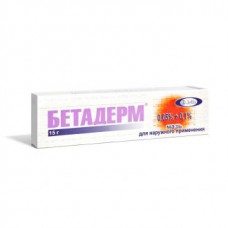Expiration date: 08/2026
The composition and form of issue:
The ointment for topical application 1g contains active substances:
betamethasone 0.5 mg
(as betamethasone dipropionate)
gentamicin 1,0 mg
(in the form of gentamicin sulphate)
excipients: liquid paraffin — 250 mg lanolin alcohol 30 mg cetostearyl alcohol (cetyl alcohol — 60%, stearyl alcohol — 40%) — 20 mg butylhydroxytoluene — 0,05 mg butylhydroxyanisole — 0.05 mg jelly, up to 1 g
tube aluminum with polished inner surface 15 g in a cardboard bundle 1 tuba.
Description pharmaceutical form:
Translucent mass of white or nearly white.
Pharmacokinetics:
Suction
Betamethasone easily penetrates the skin through the stratum corneum. No biotransformation in the skin and penetrates through it into the body. The absorption of the betamethasone through skin increases with use on the delicate skin in the crease area, when applied on the skin with a damaged skin or skin damaged by the inflammatory process. In addition, the absorption increases with the frequent use of this drugs or after application on the large surface of the skin.
Gentamicin after topical application to intact skin, not absorbed, and after the application on skin damaged by pathological process, can be absorbed into the bloodstream.
Metabolism
Betamethasone biotransformiroetsa mainly in the liver.
Excretion
Betamethasone in the form of compounds with glucuronic acid and a small amount in unchanged form mainly eliminated via the kidneys and in lesser quantities — in the bile.
Gentamicin is not biotransformiroetsa in the body and eliminated through the kidneys in an unmodified form.
Description pharmacological action:
Properties of the drug Betaderm due to the combined effect of betamethasone and gentamicin.
Betamethasone is a synthetic fluorinated derivative of hydrocortisone, has strong anti-inflammatory, antipruritic, antiallergic and vasoconstrictor actions. Reduces inflammation by suppressing the production of PG and LT due to inhibition of the activity of phospholipase A2 and reducing the release of arachidonic acid from the phospholipids of cell membranes, and has anti-allergic effect. Due to local vasoconstrictor action reduces the exudative reaction. Accelerates the biotransformation of protein in the skin and impairs proliferative processes.
Gentamicin refers to an antibiotic of the aminoglycoside, active against gram-positive bacteria (Streptococcus spp. group A — &beta-hemolytic and alpha-hemolytic, Staphylococcus spp. — Staphylococcus aureus — coagulasepositive and coagulasepositive and some strains producing penicillinase), gram-negative bacteria (Escherichia coli, Proteus spp., Pseudomonas aeruginosa) and bacteria of the group Klebsiella spp. Enterobacter spp. Serratia spp. Citrobacter spp., Salmonella spp. and Shigella spp.
Indications:
Dry, inflammatory skin condition (dermatitis), complicated by secondary bacterial infection and occur with a hyperkeratosis, itching:
- atopic dermatitis
- seborrheic dermatitis
- simple chronic zoster
- eczema
- psoriasis
- allergic contact dermatitis
- lupus erythematosus (cutaneous manifestations)
- polymorphic erythema.
Contraindications:
- hypersensitivity to the drug
- viral and fungal skin infections
- cutaneous manifestations of syphilis
- tuberculosis skin
- pink and acne vulgaris
- phlebitis and venous ulcers
- the period of vaccination and post-vaccination skin reaction
- children up to age 2 years
- pregnancy
- lactation.
Caution: atrophy of subcutaneous tissue in the elderly.
Application of pregnancy and breast-feeding:
Do not use in pregnant women. At the time of treatment should stop breastfeeding.
Side effects:
Very rarely with the use of the drug Betaderm marked: burning sensation, erythema, exudation, pigmentation and itching.
Can appear: acne, steroid purpura, inhibition of growth of the epidermis, atrophy of subcutaneous tissue, dry skin, depigmentation or hyperpigmentation of skin, skin atrophy and striae, telangiectasia, folliculitis. Sometimes it may appear urticaria or maculopapular rash.
With prolonged use or when applied to a large surface are possible systemic side effects characteristic of corticosteroids (inhibition of the function of the adrenal cortex, increasing of body mass, osteoporosis, increased blood pressure, edema, ulceration of the mucous membrane of the gastrointestinal tract, the exacerbation of latent foci of infection, hyperkalemia, agitation, insomnia, menstrual disorders).
After applying on the skin the product can cause okolorotova dermatitis, and when applied to the skin of the eyelids can sometimes exacerbate the manifestations of glaucoma, or acceleration of cataract development. In addition, given the availability of content gentamicin, can appear the symptoms of ototoxicity if the drug is applied to mucous membranes or significant surface of the skin, particularly damaged by the disease process.
In children (side effects are additional side-effects in adults) — inhibition of the hypothalamic-pituitary-adrenal syndrome, Cushing's, growth retardation, delay in body weight increase, increase of intracranial pressure (betamethasone).
Drug interactions:
Drugs can potentiate the effects of immunosuppressive drugs and to reduce the effect of immunostimulating drugs.
Method of application and dose:
Externally.
Applied a small amount of medication to the affected skin surface 1-2 times a day. Continuous use of the drug during the week should not exceed 45 g Duration of treatment depends on the efficacy and tolerability of therapy, and is usually not more than 2-4 weeks.
Overdose:
Overdose is very rare. However, with prolonged use, and the use of local corticosteroids on a large surface it is possible to suppress function of the adrenal cortex with the development of secondary adrenal insufficiency and symptoms of hypercortisolism, including the syndrome Itsenko-Kushinga.
Overdose of gentamicin may lead to the growth of insensitive flora.
Treatment: symptomatic acute symptoms of hypercortisolism are usually reversible if necessary, a correction of electrolyte balance.
Precautions:
You should avoid prolonged use, as this increases the frequency of occurrence of side effects and may develop bacterial resistance to gentamycin.
You should not use LS on the face in connection with the possibility of the appearance of telangiectasias even after short use. Avoid contact of the drug Betaderm eyes and periorbital region.
Some areas of the body (inguinal folds, armpits and perianal region) are more vulnerable to the risk of striae. Therefore, the duration of the drug in these areas should be restricted.
Long-term use of the drug Betaderm on large surfaces of the skin with impaired integrity there is a potential possibility of absorption of gentamicin and, therefore, the development of symptoms of ototoxicity.
You should not use the drug under occlusive dressing.
If there is an urgent need bandaging, it is necessary to apply a bandage, breathable, and not use a sealing, oilcloth dressing.
In cases of fungal superinfection required the additional use of antifungal drugs.
Children
Children are allowed use of the drug with two years on strict conditions and under the supervision of a physician.
Due to the fact that the kids area of the skin relative to body weight more underdeveloped and also the epidermis that topical application of the drug may absorption proportionally larger number of active substances and, consequently, there is a greater risk of systemic side effects. To use the drug in children should be as soon as possible and in compliance with all precautions.
Effects on ability to drive or to perform work requiring high speed physical and mental reactions
Data on adverse effects of the drug on the ability to drive vehicles and mechanisms do not exist.


